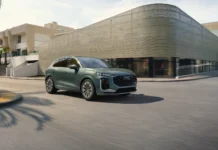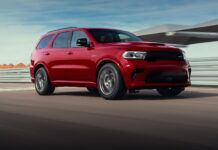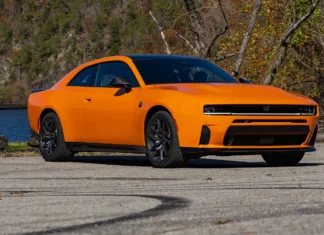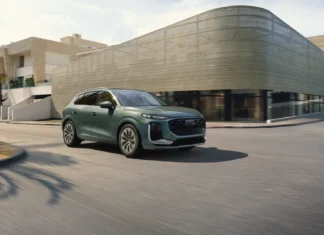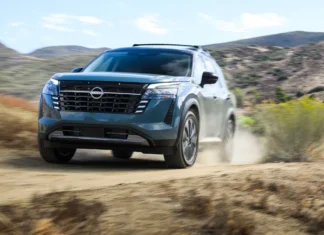2018 Toyota TRD Off-Road Premium: Sticking to Basics
Driving the 4Runner will immediately remind you what SUVs were like in the good old days. Despite its $42,690 asking price, the 2018 Toyota 4Runner TRD Off-Road Premium lacks some of the basic features you’d expect in a modern SUV. It’s 2018, after all. So does the 4Runner have modern safety features, like blind-spot monitoring? No, it doesn’t. Can you get lane-departure warning, automatic emergency braking, or adaptive cruise control. Nope. You get a steering wheel, accelerator and brake pedals, windows, and mirrors. Beyond that, you’ll have to figure it out.
In short, there’s not a big safety net to keep you out of trouble. It does feature Toyota’s Star Safety system, which includes passive safety features such as Traction Control, Stability Control, ABS, and Brake Assist, and a fair amount of airbags, but that’s it. You do also get navigation and touchscreen infotainment with Toyota’s Entune system, but no Android Auto/Apple CarPlay support.
The 2018 Toyota 4Runner TRD Off-Road Premium sits just below the hardcore TRD Pro model and above the base SR5. If you’re looking for more of an urban animal, you can opt for the Limited spec instead, which swaps out the 17-inch wheels for some nice 20-inch alloys. The TRD Off-Road lacks the Pro’s Bilstein shocks and specially-tuned front springs, TRD-stamped skid plates and black painted wheels. However, it has everything else you need to go far, far off-road, when the mood takes you.
Powertrain and dynamics
All 4Runners come with a 270 horsepower, 278 lb-ft torque 4.0-liter V6. No direct injection or forced induction tricks here. Its five-speed automatic transmission shifts smoothly on the road, but don’t expect great fuel economy. At an EPA-rated 17 City/20 Highway/18 Combined MPG, it’s better than expected (I averaged 17.5 MPG), but its older transmission holds the 4Runner’s highway economy back against competitors with 6-speeds or more.
Bringing the Off-Road Goods
Full disclosure, I did not have the opportunity to fully test the 4Runner TRD Off-Road Premium’s limits. Winters in Colorado aren’t a great time for whimsical off-roading unless you’re seriously well-equipped and have another vehicle along. However, I did take the 4Runner to some lighter (dry) trails outside Nederland, Colorado, where I could test the truck’s off-road kit.
The dirt roads rising gradually out of Nederland were no challenge to the 4Runner. Its Bridgestone Dueler H/T 684II tires are road-biased tires, but they do offer reasonable grip on light off-road duty. As the elevation rose and the temperature dropped, the journey started to get icy.
Closing in on the old Cross Mine and the ghost town of Caribou, the dirt road ended and the trails became steep and rocky. The first part was dry, fortunately, so I seized the opportunity to test the 4Runner’s low range and Crawl Control. Reaching directly above the windshield, you can use two switches to engage the truck’s Multi-terrain Select and Crawl Control. The former has four modes: Mud and Sand, Rock, Mogul, and Loose Rock. Each mode tailors the 4Runner’s performance to that sort of terrain. Setting it up in Rock mode, I also tried out Crawl Control, which allows you to select a speed from 1 to 5 MPH, where the system takes over controlling your steering and braking. You must use Crawl Control in 4-Low, and it automatically disengages the traction control.
TFLcar’s Take
If you look at the 4Runner as any other car, you may struggle to justify it. It’s plastic-riddled interior, while extremely well put together, doesn’t make the truck feel like a $43,000 product. Its infotainment screen is small by modern standards, and with the exception of the off-road systems, nothing feels particularly refined.
But that’s not the point. The 4Runner TRD Off-Road Premium is a shining beacon of everlasting dependability and rugged charm. That money you spent is all but justified under the skin. 4Runners are some of the longest-lasting cars out there, full stop. This particular model sports fantastic off-road ability. The controls, while inelegant, are chunky and solid. The rear window slides down with the push of a button or the turn of a key on the tailgate – how cool is that? As a boxy SUV, it also provides ample cargo space for all the adventures you’re sure to have.
As a modern SUV, the 4Runner is deeply flawed. But because its flawed, the living experience, at least for me, was remarkable. I was looking forward to driving a 4Runner again, and I wasn’t disappointed. When you look at it in perspective for its off-road ability and charisma, you can’t help but love it. SUV shoppers must agree, as 4Runner sales have increased by a huge margin over the past five years.
SPECIFICATIONS: 2018 Toyota 4Runner TRD Off-Road Premium
| On Sale: | Now |
| Base MSRP: | $39,495 |
| Price as Tested: | $42,690 (including desination charges) |
| Engine: | 4.0-liter, naturally-aspirated V6 w/ Dual-VVTi |
| Drivetrain (Layout): | Longitudinally-mounted front-engine, four-wheel drive |
| Horsepower: | 270 hp @ 5,600 RPM |
| Torque: | 278 lb-ft @ 4,400 RPM |
| Transmission: | Five-speed automatic |
| Suspension: | Front: Coil spring independent double-wishbone suspension w/ stabilizer barRear: Coil spring 4-link rigid type w/ stabilizer bar |
| Brakes: | Front: 13.3-inch ventilated discsRear: 12.3-inch solid discs ABS, EBD, Brake Assist and Vehicle Stability Control |
| Tires: | Bridgestone Dueler H/T 684II P265/70 R17 113S |
| Fuel capacity: | 23.0 gallons |
| Fuel economy (EPA): | 17 City/20 Highway/18 Combined MPG |
| Drag Coefficient: | 0.36 |
Dimensions:
| Wheelbase: | 109.8 inches |
| Length: | 191.3 inches |
| Width: | 75.8 inches |
| Height: | 71.5 inches (w/ roof rack) |
| Cargo Volume | Seats up (w/ slide deck): 46.3 cubic feet Seats down (w/ slide deck): 88.8 cubic feet |
| Ground Clearance: | 9.6 inches |
| Approach Angle: | 33 degrees |
| Departure Angle: | 26 degrees |
| Turning Circle: | 37.4 feet |
| Curb Weight: | 4,750 pounds |
